|
| |
 |
ANTIQUE BOXES
at the Sign
of the Hygra
2 Middleton Road
London E8 4BL
Tel: 00 44 (0)20 7 254 7074
Fax: 00 44 (0) 870 1257669
email: boxes@hygra.com |
Antique Boxes in English Society
1760 -1900
by
ANTIGONE
ANGLO INDIAN
BOXES |
News
| Buying
| Contact us
| Online History of boxes
| The Schiffer Book | Advanced
Search
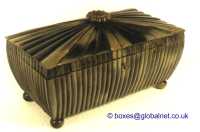
Anglo Indian three compartment Tea
Caddy in reeded horn. |
Anglo Indian boxes were made in India for the English residents from the
early part of the 18th century. They were brought back or sent back to England
usually by the people who had commissioned them. From the beginning of the
nineteenth century they were imported more commercially, although not in
any significant numbers until the middle decades. They were very highly valued,
especially the early ones, to the extent that the designs were copied on
late 19th and early 20th century tins.
|
The rich timbers and the intricate workmanship that is found in India in
the early part of the 18th century caught the attention of the English traders
and officials. The potential work of the Indian artist/craftsman was recognized as a source for satisfying the need for furniture and boxes, which would
both, serve and enhance the English household. This gave rise to the cabinet
making workshops, which were established in Vizagapatam (between Calcutta
and Madras).
 |
A double opening or triple writing box of c 1835 made in
India from rosewood inlaid all over with ivory, the top edged
with a chevron pattern of ebony and ivory and with countersunk handles and
brass straps.
For more pictures and information click
here. |
The first boxes were made of rosewood or ebony with ivory directly inlaid
into the wood. The ivory was incised to give further definition to the
decoration. The shape of the early boxes was either sloping at the front
with a flatter section at the back, reminiscent of English writing slopes,
or rectangular. The borders were inlaid with stylized floral scrolls and
the centers with a single floral motif following a circular or oval symmetrical
or asymmetrical pattern. The edging was of ivory pinned with ivory pins,
or a combination of ivory and wood. This served a dual purpose, both ornamental
and protective of the end grain against weather conditions.
The style of the ornaments on the early boxes is formal yet flowing and robust.
A perfect compliment to the strength and figure of the rosewoods.
The boxes often had silver escutcheons and drop handles. Boxes of this type
were made up to the middle of the 18th century and are now very rare.
Ivory inlaid boxes in more conventional English shapes, such as writing,
document and jewellery boxes were made later in the 18th and 19th centuries.
The designs by this time had moved on to covering more of the box in a more
integrated pattern, or to simple edge decoration with a small central motif.
Good examples from this period are also rare.
The second group of Anglo Indian boxes were made in sandalwood and veneered
in ivory, tortoiseshell, horn or quills.
From the middle to the end of the 18th century ivory and tortoiseshell veneered
boxes were usually of rectangular shape. They stood on a narrowly protruding
base and the lid, which was just flat, also protruded to the same extent
as the base. Sometimes the larger boxes had drop handles.
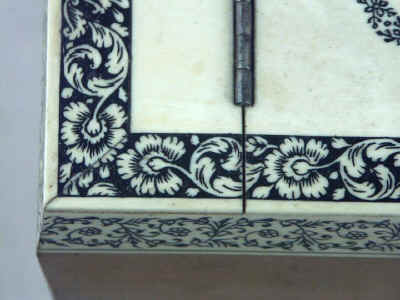
|
The ivory is
decorated by being engraved depicting scrolling flowers and leaves.
Black lac fills the incised ivory giving contrast.
|
|
The decoration took the form of a border of ivory. The ivory was incised
and filled with black lacquer to form intricate floral motifs. In addition
to their beauty, the borders also disguised the joints in the ivory and
tortoiseshell pieces, which were, because of their nature, of restricted
size. Like the earlier boxes, they were edged in decorated ivory, which sealed
the end grain and protected it from moisture.
|

Anglo-Indian (Vizagapatam) box in wood covered in horn, of sarcophagus form, with a segmented radiating top culminating in a turned and carved floral finial. An Indian interpretation of English Regency aesthetic. This is a small box which shows absolute mastery of design. Circa 1840.

An Anglo Indian Vizagapatam radiating faded black buffalo horn of dramatic curved shape Circa 1835
|
|
By the last two decades of the 18th century the densely engraved borders
gave way to Neo Classical designs which were already fashionable in England.
The decoration became more linear with delicate garlands and Greek key patterns
in the style of Robert Adam. The protruding lids gave way to deeper lids
of four sides and top, structured in the conventional English way. Bases
were no longer protruding.
By the end of the 18th century quills and horn were also used as veneers,
the quills mostly with ivory borders decorated in the incised and black lacquer
technique.
|

Anglo-Indian, Vizagapatam, box in the form of a basket, the wooden frame covered in porcupine quills, framed in ivory which is incised and decorated in black lacquer, with a horn handle. It stands on turned horn feet. Circa 1850.
|
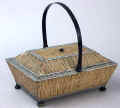
|
Anglo Indian, Vizagapatam
Porcupine Quill Horn and Ivory Basket-form box Circa 1850.
|
|
All of the veneered boxes, ivory, quill and horn, were made in different
shapes from the first decades of the 19th century. The Indian craftsmen also
made the sarcophagus and architectural shapes fashionable in England. The
decoration on the borders became more varied and sometimes it even included
oriental motifs. It is indicative of the cross cultural influences of the
time that an Anglo Indian box could be of sarcophagus shape (Egyptian influence
in England), executed in ivory, with Chinese figures incised in the border.
The interior fitted with spools and sewing implements in the English fashion.
|
.thumb.JPG)
A sandalwood basket veneered in horn and ivory. Although such baskets were a popular Vizagapatam design, this one is very unusual in that it combines both solid ivory panels incised and lac filled in traditional plant motifs and fretted ivory work. Furthermore, the central cartouches are engraved with representations of Indian deities and not floral designs which was the normal decoration on such baskets. It stands on lion paw feet. The handle is decorated with scrolling flowers in characteristic fashion. Circa 1870.
|
|
Indian craftsmen showed incredible aptitude in adapting to the whims of the
times. Boxes even in the shape of baskets were produced in the Regency period,
although these still had the typical incised borders. This was not the case
with the "English Cottage" shaped sewing boxes, which had incised decoration
in naturalistic style with doors, tiles and climbing flowers. They were certainly
made to gratify the expatriate nostalgia for the English countryside.
|
.thumb.JPG)
Anglo Indian basket form box veneered with ebony and inlaid with Sadeli
mosaic having an ebony handle and standing on turned ebony feet the inside lined with sandalwood. circa 1840.
|
The early 19th century horn boxes were made in very robust architectural
shapes. They often had stepped or canted lids of radiating reeded segments
culminating in turned and fluted finials. They stood on turned feet, which
showed up the form to full advantage. By the middle of the century shapes
became simpler and smaller, sometimes domed, covered with flat horn veneer.
They were decorated with fretted or incised ivory strips affixed with ivory
pins.
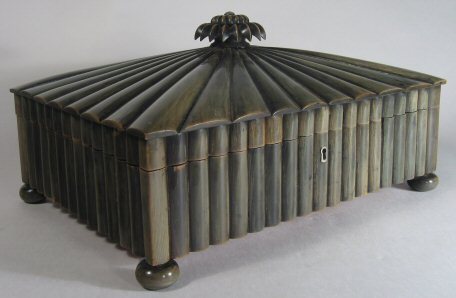
Important Green Reeded Horn Vizagagapatam Sewing box Circa 1835 (c) hygra.com
|
This is an important and impressive Anglo Indian (Vizagapatam) horn
sewing box. The top is made up of large radiating segments of buffalo
horn. In the center is a knob which is overhanging. This is turned and
carved. The whole stands on turned horn feet. It is in wonderful
condition maintaining its integrity and patina. The color is now a
green glow. The inside is sandal wood.
|
Quill boxes, which early in the 19th century were made in interesting shapes
and were of high quality, became increasingly simpler. By 1840 they had lost
their fineness. In the last decades of the 19th century they were simply
framed by ebony strips pinned with ivory or bone pins. The quills were larger
than in the earlier boxes and the basic wood was not always sandalwood.
The ancient art of Sadeli Mosaic is said to have been introduced from Shiraz
in Persia via Sind to Bombay, a long time before the Anglo Indian boxes were
made. It was a technique, which required a high degree of skill and patience.
It was executed very lavishly, in that the frequent cuts wasted a great amount
of the precious materials used. The workmanship was however more than
commensurable to the value of the materials.
Ivory, silver, pewter (or other metals), wood and horn were cut into faceted rods
which were bound together to form geometric patterns. When the glue has set,
the rods were sliced in transverse sections. This gave the maker a number
of angled circular pieces in the original pattern. Several variations of
patterns could be achieved by combining the materials in different ways.
The ivory was sometimes dyed green to give an extra colour.
The mosaic pieces in a combination of patterns, often separated by ivory,
ebony, horn or silver stringing were used to veneer sandalwood boxes. In
the early boxes, which date from the turn of the 18th to the 19th century,
there are large panels of mosaic covering tops and sides of boxes. It took
incredible skill to cover such large areas without any shakes or wavering
of the pattern. The corners and joins on these boxes are impeccably matched.
The makers (reputed to be Persian) of Sadeli mosaic made in the first two
decades of the 19th century displayed a total understanding of the qualities
of the different materials they used. They combined substances, which can
expand and contract according to atmospheric conditions with others, which
are hard and unyielding. The result was a sharp definition of the lines and
patterns, which made up the whole design.
On the early boxes the designs look deceptively simple. The fact is, they
emerged from a culture, which had mastered geometry and understood how to
generate a pattern from a set number of points. The patterns are so harmoniously
combined that their incredible complexity is not immediately apparent.
The earliest Sadeli boxes are of simple rectangular shapes. The combination
of the diverse patterns is a triumph of artistic judgment, impeccable
workmanship and deep respect for the material in hand. The boxes have an
opulence emanating from the richness of the materials, yet the total control
of these materials and the cerebral nature of the overall designs give them
a restrained dignity. These early Sadeli boxes are now very rare indeed.
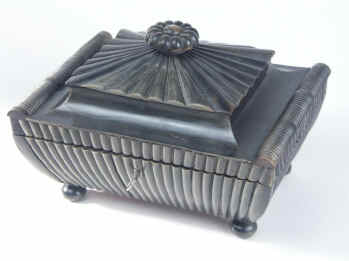
|
The craftsman who made
this box has pushed his materials to the extreme to achieve this
dramatic shape. The radiating horn top is surmounted by a turned and
carved knob.
There has been some
cracking of the horn in the curved sections at the front and one side.
This is visible in the enlargement of this image.
A radiating black buffalo
horn Vizagapatam antique fitted sewing box of dramatic curved shape
standing on turned horn feet having a lift out horn edged sandalwood
tray with three further radiating horn lids.
|
By the 1820s few boxes were made which were completely covered in Sadeli
mosaic. The few, which were, were in sarcophagus, architectural, domed, basket
and other shapes of the period.
In the second half of the 19th century Sadeli mosaic was made by several
more workshops. The accuracy of execution and the sharpness of design suffered,
although boxes from this period are pretty and more possible to find.
The carved Anglo Indian boxes fall into two very distinctive categories:
1. Early 19th century sandalwood boxes which were finely carved with repetitive
floral and bird motifs and
2. Later 19th and 20th century wooden boxes much more crudely carved with
or without late period Sadeli mosaic.
There are of course variations in the quality of these later boxes and some
of them are very striking.
Boxes from the first category are very rare.
|
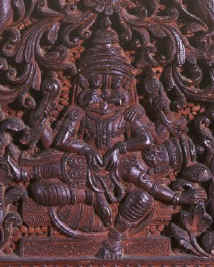
Click on picture or
here to see more details of this South Indian cabinet.
|
News
| Buying
| Contact us
| Online History of boxes
| The Schiffer Book | Advanced
Search
© 1999/2002 Antigone Clarke and Joseph O'Kelly
|
